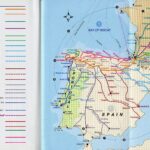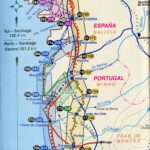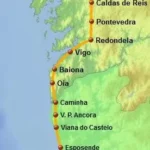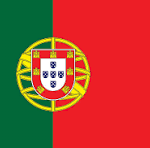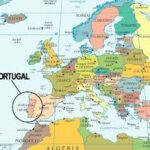On the road again.
Just can’t wait to get on the road again.
Last year while we were walking around the Isle of Portland section of the South West Coast Path, we met a lady from Nova Scotia, Canada who was also walking some of the path. As usual we compared notes on the different places we had walked. She had walked the Dingle and Kerry Peninsulas which we had done in 2017. In 2022 she walked the Camino Portugués and the way she talked of it piqued our interest.
After walking the Camino Frances in 2016 we always had in the back of our minds going back and repeating some of it as we had enjoyed it so much. We were aware of the Camino Portugués but had not looked at it in any detail. After talking with the lady from Nova Scotia we researched it a lot more and looked at dozens of You Tube videos.
It looked like an interesting and manageable walk. Fairly flat – much less climbing than the Camino Frances, Ireland or the South West Coast Path. If we started in Porto the distance of 270km was about right for us these days. The journey could be split up into walking day lengths of about 20km interspersed with “rest” days. We have never been to Portugal before and I like going to new places. Lisbon and Porto look like beautiful historic cities. The food and wine in Portugal are renowned. Also in contrast to the Camino Frances which was 100% inland, 70% of the Coastal Way follows the shoreline with lots of pristine beaches and opportunities for swimming.
So that was that, we decided to do it.
There are at least 14 Caminos that I am aware of, starting in different parts of France, Spain and Portugal but all ending in Santiago de Compostela Spain. Last year 442,073 pilgrims successfully completed a Camino route. 219,785 did the Camino Frances, 88,717 the Camino Portuguese Central, and 52,746 the Portuguese Coastal route.
- Some of the Camino routes
The full Camino Portugués starts in the capital of Portugal, Lisbon, and finishes in Santiago de Compostela, Spain. It is about 640kms. We are walking from Portugal’s second largest city Porto to Santiago de Compostela, about 270kms.
The Camino Portugués, O Caminhos Portugueses, is a general heading with at least four alternate routes: the Central Way (Caminho Central), Coastal Way (Caminho da Costa), Seashore Path (Senda Litoral), and Spiritual Variant (Variante Espiritual).
- The Camino Portugueses routes
In Portugal the main historical route is the Central Way, an inland route, and is the most popular and busiest. The Coastal Way follows the coast from Porto before joining the Central Way at Redondela and going on to Santiago de Compostela. The Senda Litoral and Spiritual Variant are variations of the Coastal Way. You can see the routes in the map above. The Coastal Way, while not the traditional route for purists, is becoming more popular and is promoted by Portuguese Tourism to get better wayfinding and infrastructure (accommodation, food, transport, medical facilities etc).
We are walking the Coastal Way from Porto to Santiago de Compostella by way of Matosinhos, Villa do Condo, Povoa de Varzim, Esposende, Viana do Castelo, Caminha, A Guarda, Oia, Baiona, Vigo, Redondela, Pontevedra, Caldas de Reis and Padron.
- The Camino Portuguese Coastal Way from Porto to Santiago
We are using a tour company, Caminoways, to book our accommodation and transport our bags eash day. We have previously used Caminoways when we walked the Camino Frances in 2016, and the Dingle, Kerry and Beara Peninsulars in Ireland in 2017. In those days you used to get paper maps but now they have an app for your phone which shows the exact route and you can follow your progress by way of your blue dot on the path. It is pretty much impossible to get lost if you are using the app. When we used Macs Adventures on the South West Coast Path they also had an app of the route and many times it saved us from taking a wrong turn and getting lost, or walking a lot of unnecessary kilometres.
- Flag of Portugal
- Map of Europe

